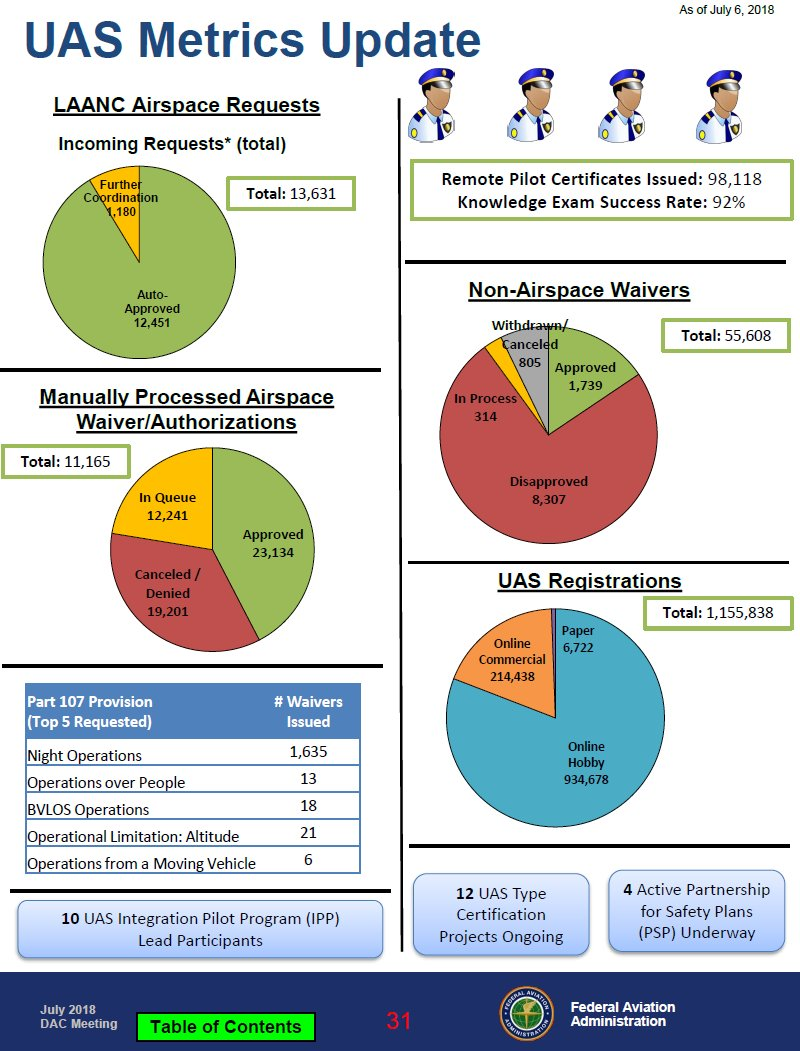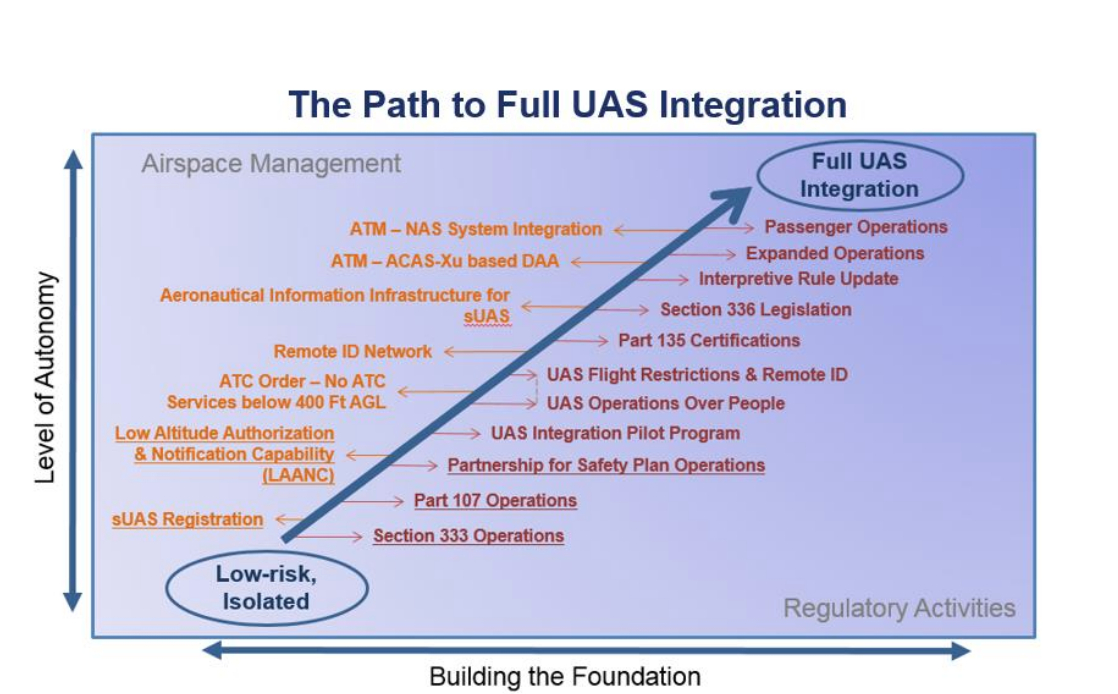
The FAA’s Drone Advisory Committee (DAC) recently met in Santa Clara, CA. Updated LAANC stats and an extensive discussion of Remote ID were the main highlights.
Quick Update on LAANC
The FAA shared some interesting updates on LAANC. As of July 6, 2018, there have been a total of 13,631 LAANC Airspace Requests. Of those, 92% have been auto-approved, while only 8% required further coordination. By September 2018, the FAA anticipates LAANC availability at nearly 300 air traffic facilities covering approximately 500 airports. Check out the infographic on the next page for some updated stats on LAANC, Registration, Waivers, the Part 107 knowledge, and more!
Andrew’s take: These numbers are promising because they show LAANC is largely working as expected — and should be a game-changer for commercial operations. LAANC authorizations turn a 90-day process into a 90-second process, and with a 90%+ approval rate, commercial drone pilots will be able to fly more missions with more certainty and predictability. In March 2018, FAA officials reported that 32,000 flight authorizations had been processed as of that date. Putting this into perspective, LAANC (in a few months) has already processed almost 30% of all UAS airspace authorization requests that the FAA has processed in its entire history.
Remote ID
DAC took a deep dive into Remote ID. The general consensus was that Remote ID is important and necessary, and — while safety is the number one priority — time is of the essence.
The industry views Remote ID as necessary to unlock further UAS integration into the National Airspace (NAS). Beyond Visual Line of Sight (BVLOS) operations, one of the advanced operations closest to being realized makes robust Remote ID necessary because the operator and the aircraft will be further away from one another, and the operator must know where the drone is at all times.
The security and defense community views universal Remote ID as necessary to help identify the large majority of law-abiding drone pilots and separate them from, as one committee member said, “the nefarious, the clueless, and the careless”. First Responders interacting with drones seek two pieces of information about the operator and aircraft — who are you, and are you authorized to fly here? Remote ID and LAANC go hand-in-hand to address these questions.
The FAA, to its credit, acknowledged the many interrelated moving parts needed to implement and make standards for Remote ID. For example, three standards bodies are debating standards for Remote ID (ASTM International, SAE International, and the Consumer Technology Association) at the same time multiple Remote ID rule proposals are floating around Congress. This shows the speed at which industry wants a standard to develop as well as the challenges of having too many cooks in the kitchen. It is difficult to solve any of these issues in a vacuum, and even more so to solve them all at once.
Andrew’s take:
It is very unlikely Remote ID will be in place next summer as the FAA timeline states. DAC wants Remote ID rules in place yesterday and says they will have trouble moving forward without rules. The problem is that both the FAA and DAC are still waiting for guidance from Congress regarding who will need to be covered by Remote ID, who exactly will have to comply, and what compliance will look like. Currently, the FAA does not expect a Notice of Proposed Rule-Making (NPRM) for UAS Remote ID until Spring 2019. With midterm elections looming in November, the odds of Congress making quick progress is low. There are also competing amendments working their way through the House, both of which nominally support moving forward on Remote ID in different ways. However, there is still a lot of lobbying and negotiating to do before a comprehensive solution is finalized. Depending on the results of this process, it could take months into the new Congress to realize any movement on this issue.
The FAA emphasized that they want to avoid picking winners and losers or the perception of doing so — implying that industry should fight it out. They seem to want that fight to continue until, hopefully, and simultaneously, a critical mass of industry, government, hobbyist, and security interests coalesce around one set of standards AND Congress provides clear rules on who will be required to have Remote ID. It is a difficult coordination problem for the FAA to determine final rules and standards at the same time without putting their hand on the scale.
Conclusion — What can we expect between now and the next DAC meeting?
DAC meets quarterly, so there is a lot that can happen between now and the next meeting, scheduled to be held in Washington D.C. in mid-October. By that time it should be clear whether Congress will be providing any additional clarity on UAS this year. The industry will continue to work somewhat individually on the specific Remote ID solutions that will enable them to support their waiver applications for advanced operations or UTM services.
Two publicly available infographics provided to DAC meeting attendees:


Andrew Elefant
Andrew Elefant is the Director of Legal & Policy at Aloft, an enterprise drone software company. Andrew is a licensed attorney in California. He is also an experienced Private Pilot with Instrument and Multi-Engine ratings, as well as a certificated Remote Pilot.



